Abstract
1. The mechanism for the stereospecific recognition of the antagonist S-145 by the thromboxane A2 (TXA2)/prostaglandin H2 (PGH2) receptor was examined by ligand-binding techniques in rat vascular smooth muscle cells (VSMCs) and in human platelet membranes. 2. Scatchard analysis revealed the existence of a single class of binding sites with the same maximum number for both [3H]-(+)-S-145 and [3H]-(-)-S-145 in both cell types. The dissociation constants (Kd) for the binding of the (+)-isomer in rat VSMCs and human platelet membranes were, respectively, 0.40 +/- 0.03 and 0.20 +/- 0.02 nM, each value being lower than that for the (-)-isomer (3.57 +/- 0.74 and 2.87 +/- 0.08 nM, respectively). 3. The rank orders of potency (Ki) for a series of TXA2/PGH2 ligands at inhibiting [3H]-(+)-S-145 binding were highly correlated with those determined for [3H]-(-)-S-145 binding in both cell preparations. 4. Kinetic analysis of the binding of both radioligands revealed a much lower dissociation rate constant (k-1) and a slightly greater association rate constant (k1) for the (+)-isomer compared to those for the (-)-isomer. 5. These results suggest that it is at the stage of dissociation from the TXA2/PGH2 receptor that the stereochemistry of the optical isomers of S-145 confers their difference in affinity for these receptors in rat VSMCs and human platelet membranes.
Full text
PDF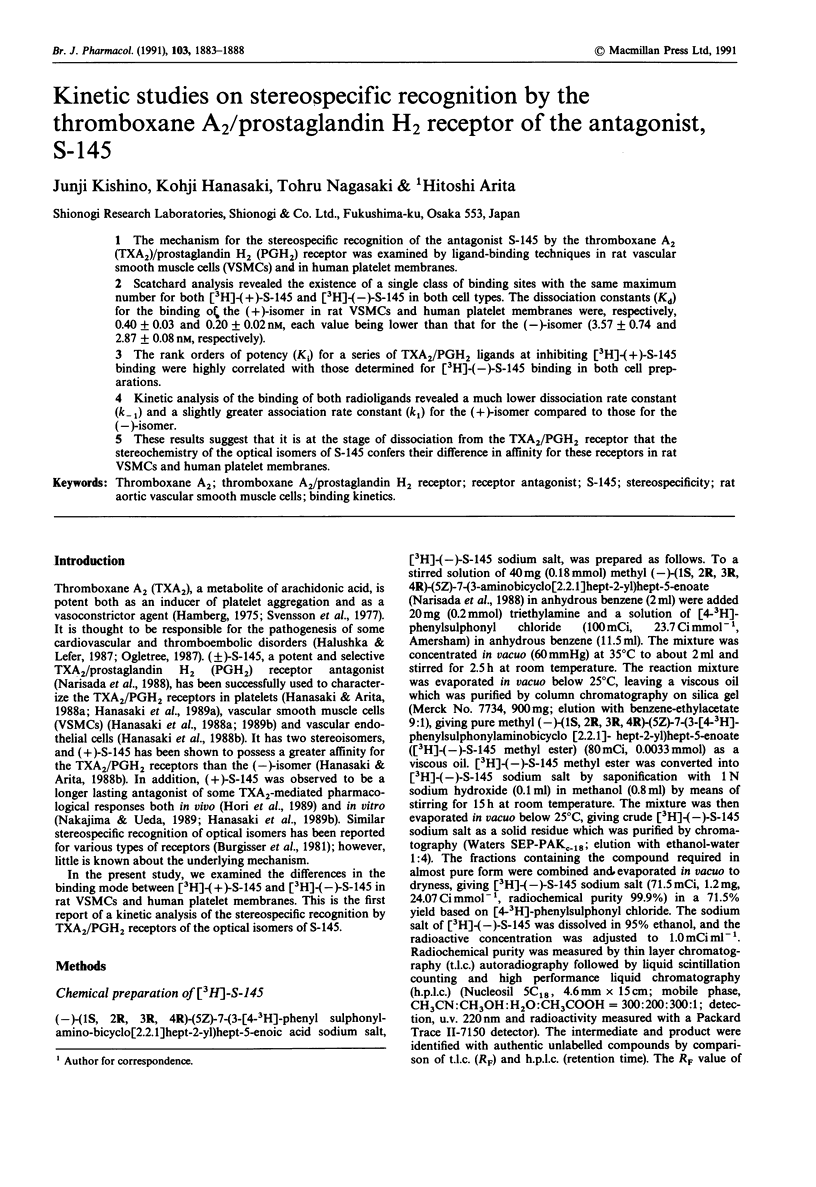

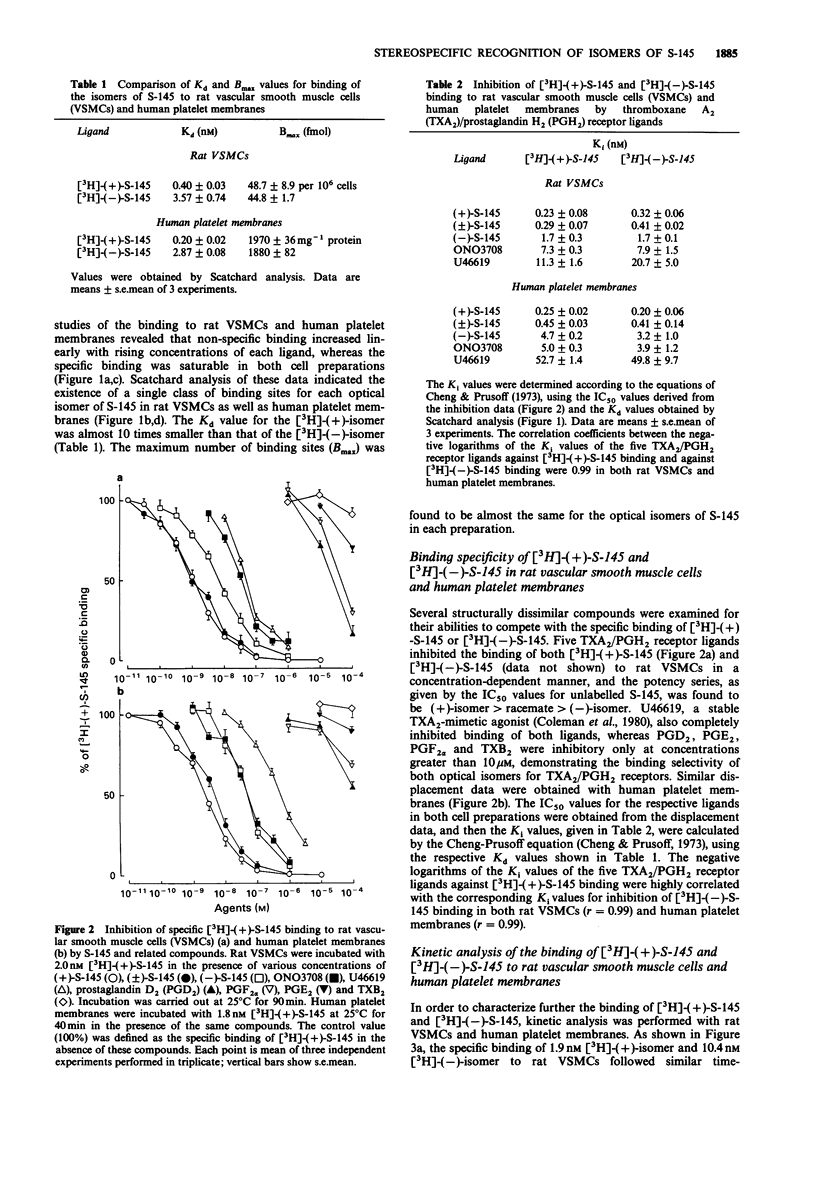
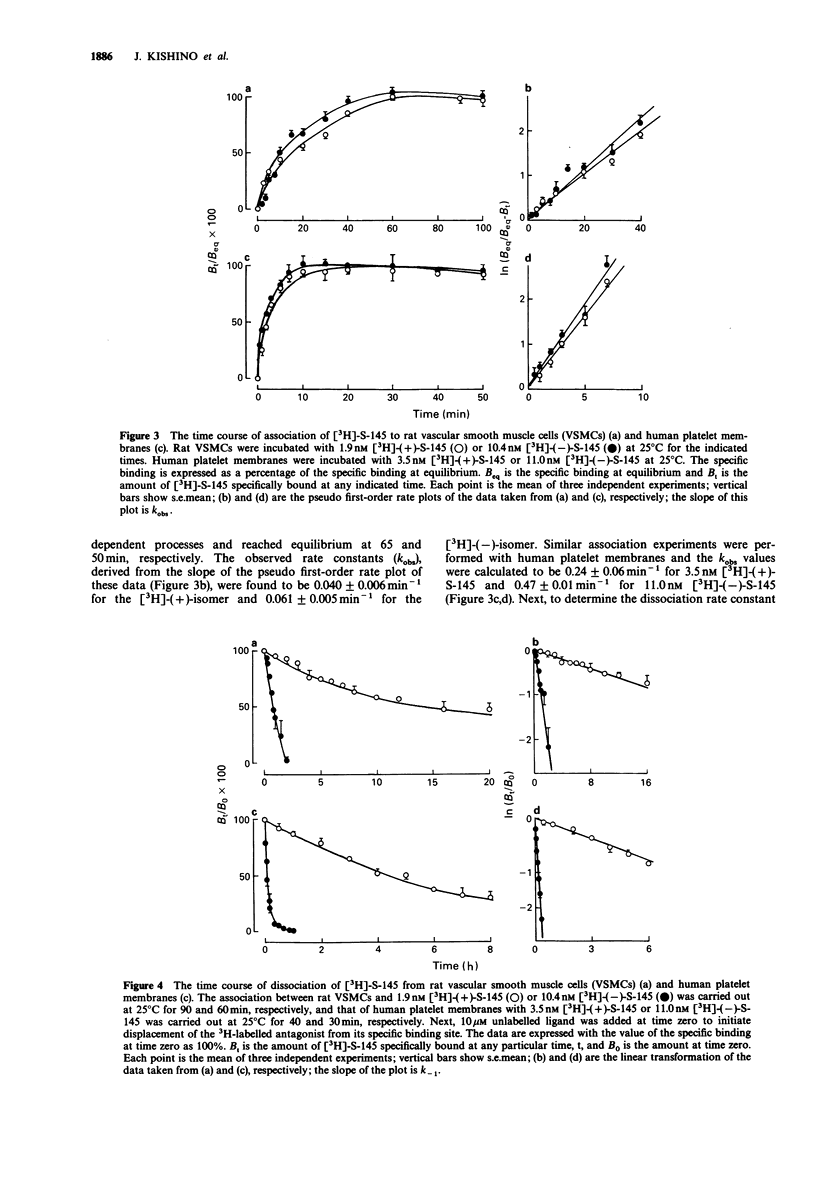
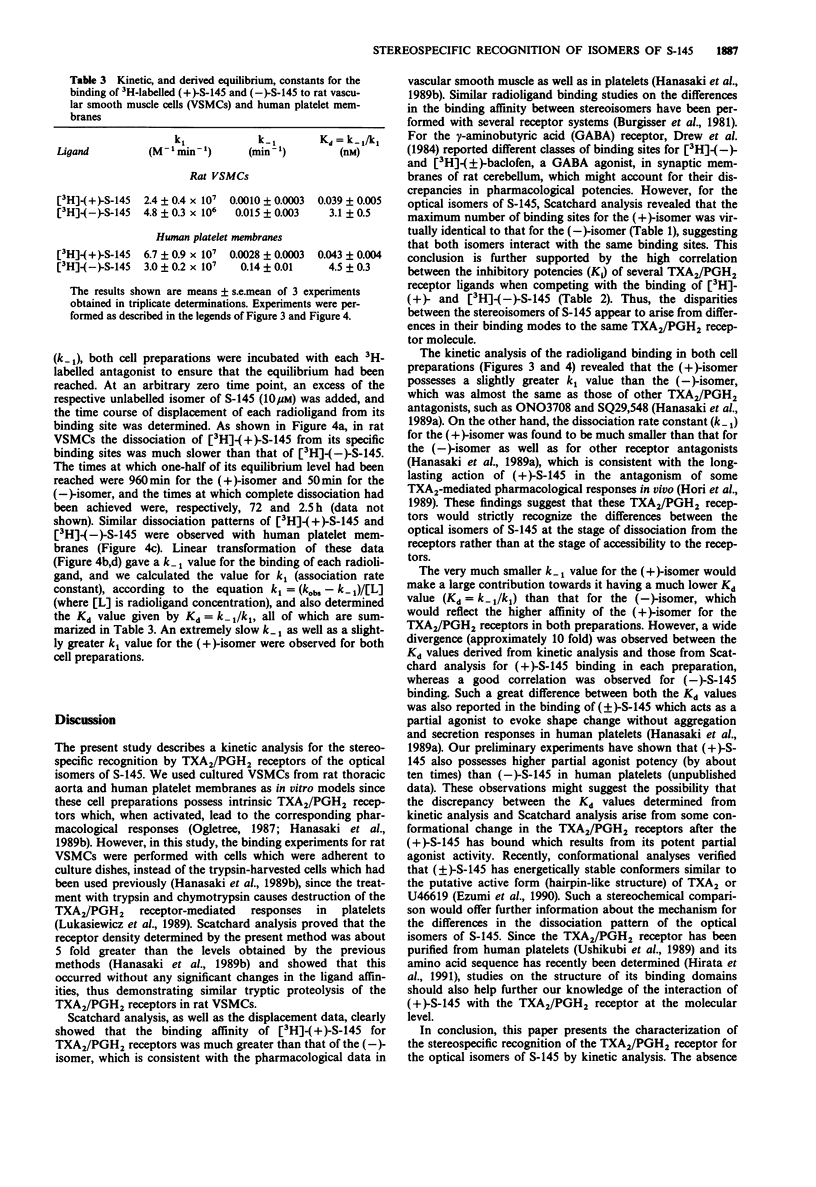
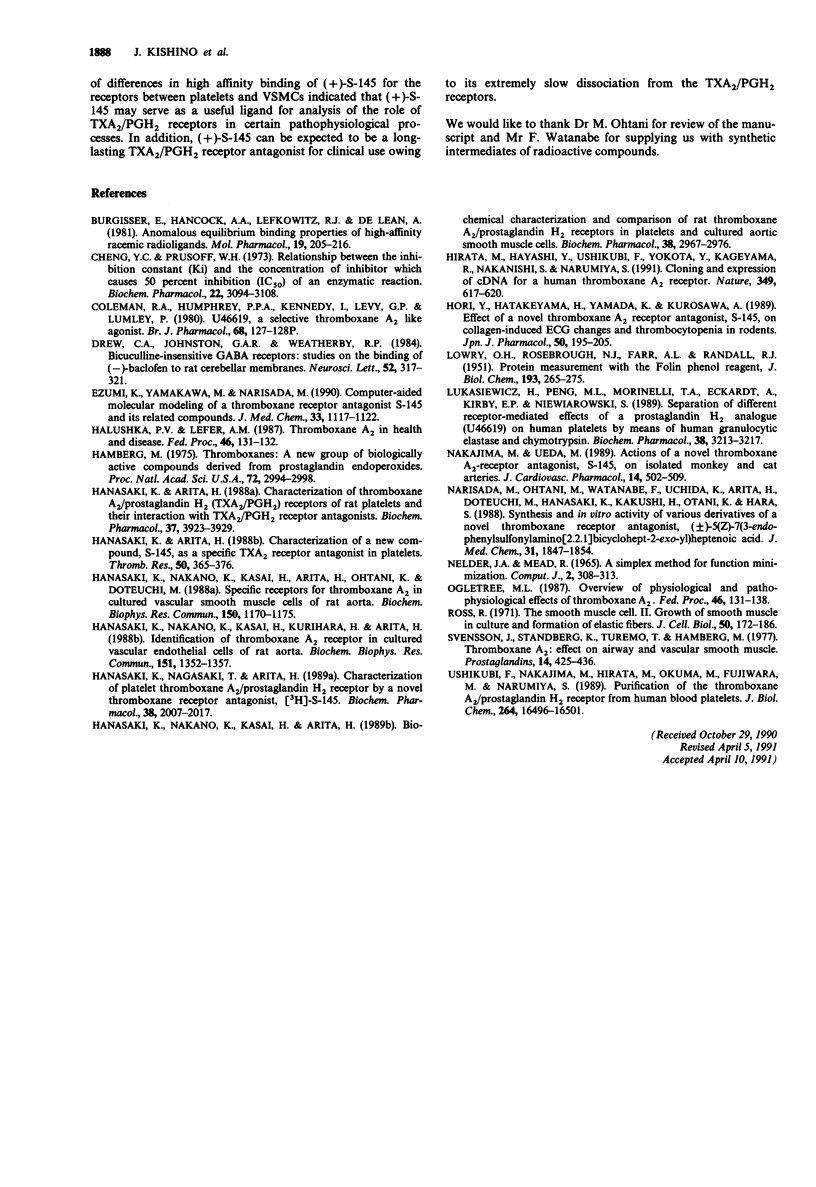
Selected References
These references are in PubMed. This may not be the complete list of references from this article.
- Bürgisser E., Hancock A. A., Lefkowitz R. J., De Lean A. Anomalous equilibrium binding properties of high-affinity racemic radioligands. Mol Pharmacol. 1981 Mar;19(2):205–216. [PubMed] [Google Scholar]
- Cheng Y., Prusoff W. H. Relationship between the inhibition constant (K1) and the concentration of inhibitor which causes 50 per cent inhibition (I50) of an enzymatic reaction. Biochem Pharmacol. 1973 Dec 1;22(23):3099–3108. doi: 10.1016/0006-2952(73)90196-2. [DOI] [PubMed] [Google Scholar]
- Coleman R. A., Humphrey P. P., Kennedy I., Levy G. P., Lumley P. U-46619, a selective thromboxane A2-like agonist? [proceedings]. Br J Pharmacol. 1980 Jan;68(1):127P–128P. [PMC free article] [PubMed] [Google Scholar]
- Drew C. A., Johnston G. A., Weatherby R. P. Bicuculline-insensitive GABA receptors: studies on the binding of (-)-baclofen to rat cerebellar membranes. Neurosci Lett. 1984 Dec 21;52(3):317–321. doi: 10.1016/0304-3940(84)90181-2. [DOI] [PubMed] [Google Scholar]
- Ezumi K., Yamakawa M., Narisada M. Computer-aided molecular modeling of a thromboxane receptor antagonist S-145 and its related compounds. J Med Chem. 1990 Apr;33(4):1117–1122. doi: 10.1021/jm00166a006. [DOI] [PubMed] [Google Scholar]
- Halushka P. V., Lefer A. M. Thromboxane A2 in health and disease. Fed Proc. 1987 Jan;46(1):131–132. [PubMed] [Google Scholar]
- Hamberg M., Svensson J., Samuelsson B. Thromboxanes: a new group of biologically active compounds derived from prostaglandin endoperoxides. Proc Natl Acad Sci U S A. 1975 Aug;72(8):2994–2998. doi: 10.1073/pnas.72.8.2994. [DOI] [PMC free article] [PubMed] [Google Scholar]
- Hanasaki K., Arita H. Characterization of a new compound, S-145, as a specific TXA2 receptor antagonist in platelets. Thromb Res. 1988 May 1;50(3):365–376. doi: 10.1016/0049-3848(88)90266-6. [DOI] [PubMed] [Google Scholar]
- Hanasaki K., Arita H. Characterization of thromboxane A2/prostaglandin H2 (TXA2/PGH2) receptors of rat platelets and their interaction with TXA2/PGH2 receptor antagonists. Biochem Pharmacol. 1988 Oct 15;37(20):3923–3929. doi: 10.1016/0006-2952(88)90075-5. [DOI] [PubMed] [Google Scholar]
- Hanasaki K., Nagasaki T., Arita H. Characterization of platelet thromboxane A2/prostaglandin H2 receptor by a novel thromboxane receptor antagonist, [3H]S-145. Biochem Pharmacol. 1989 Jun 15;38(12):2007–2017. doi: 10.1016/0006-2952(89)90501-7. [DOI] [PubMed] [Google Scholar]
- Hanasaki K., Nakano K., Kasai H., Arita H. Biochemical characterization and comparison of rat thromboxane A2/prostaglandin H2 receptors in platelets and cultured aortic smooth muscle cells. Biochem Pharmacol. 1989 Sep 15;38(18):2967–2976. doi: 10.1016/0006-2952(89)90004-x. [DOI] [PubMed] [Google Scholar]
- Hanasaki K., Nakano K., Kasai H., Arita H., Ohtani K., Doteuchi M. Specific receptors for thromboxane A2 in cultured vascular smooth muscle cells of rat aorta. Biochem Biophys Res Commun. 1988 Feb 15;150(3):1170–1175. doi: 10.1016/0006-291x(88)90752-8. [DOI] [PubMed] [Google Scholar]
- Hanasaki K., Nakano K., Kasai H., Kurihara H., Arita H. Identification of thromboxane A2 receptor in cultured vascular endothelial cells of rat aorta. Biochem Biophys Res Commun. 1988 Mar 30;151(3):1352–1357. doi: 10.1016/s0006-291x(88)80511-4. [DOI] [PubMed] [Google Scholar]
- Hirata M., Hayashi Y., Ushikubi F., Yokota Y., Kageyama R., Nakanishi S., Narumiya S. Cloning and expression of cDNA for a human thromboxane A2 receptor. Nature. 1991 Feb 14;349(6310):617–620. doi: 10.1038/349617a0. [DOI] [PubMed] [Google Scholar]
- Hori Y., Hatakeyama H., Yamada K., Kurosawa A. Effect of a novel thromboxane A2 receptor antagonist, S-145, on collagen-induced ECG changes and thrombocytopenia in rodents. Jpn J Pharmacol. 1989 Jun;50(2):195–205. doi: 10.1254/jjp.50.195. [DOI] [PubMed] [Google Scholar]
- LOWRY O. H., ROSEBROUGH N. J., FARR A. L., RANDALL R. J. Protein measurement with the Folin phenol reagent. J Biol Chem. 1951 Nov;193(1):265–275. [PubMed] [Google Scholar]
- Lukasiewicz H., Peng M. L., Morinelli T. A., Eckardt A., Kirby E. P., Niewiarowski S. Separation of different receptor-mediated effects of a prostaglandin H2 analogue (U46619) on human platelets by means of human granulocytic elastase and chymotrypsin. Biochem Pharmacol. 1989 Oct 1;38(19):3213–3217. doi: 10.1016/0006-2952(89)90616-3. [DOI] [PubMed] [Google Scholar]
- Nakajima M., Ueda M. Actions of a novel thromboxane A2-receptor antagonist, S-145, on isolated monkey and cat arteries. J Cardiovasc Pharmacol. 1989 Sep;14(3):502–509. doi: 10.1097/00005344-198909000-00022. [DOI] [PubMed] [Google Scholar]
- Narisada M., Ohtani M., Watanabe F., Uchida K., Arita H., Doteuchi M., Hanasaki K., Kakushi H., Otani K., Hara S. Synthesis and in vitro activity of various derivatives of a novel thromboxane receptor antagonist, (+/-)-(5Z)-7-[3-endo-[(phenylsulfonyl)amino]bicyclo[2.2.1] hept-2-exo-yl]heptenoic acid. J Med Chem. 1988 Sep;31(9):1847–1854. doi: 10.1021/jm00117a028. [DOI] [PubMed] [Google Scholar]
- Ogletree M. L. Overview of physiological and pathophysiological effects of thromboxane A2. Fed Proc. 1987 Jan;46(1):133–138. [PubMed] [Google Scholar]
- Ross R. The smooth muscle cell. II. Growth of smooth muscle in culture and formation of elastic fibers. J Cell Biol. 1971 Jul;50(1):172–186. doi: 10.1083/jcb.50.1.172. [DOI] [PMC free article] [PubMed] [Google Scholar]
- Svenssen J., Strandberg K., Tuvemo T., Hamberg M. Thromboxane A2: effects on airway and vascular smooth muscle. Prostaglandins. 1977 Sep;14(3):425–436. doi: 10.1016/0090-6980(77)90258-1. [DOI] [PubMed] [Google Scholar]
- Ushikubi F., Nakajima M., Hirata M., Okuma M., Fujiwara M., Narumiya S. Purification of the thromboxane A2/prostaglandin H2 receptor from human blood platelets. J Biol Chem. 1989 Oct 5;264(28):16496–16501. [PubMed] [Google Scholar]


